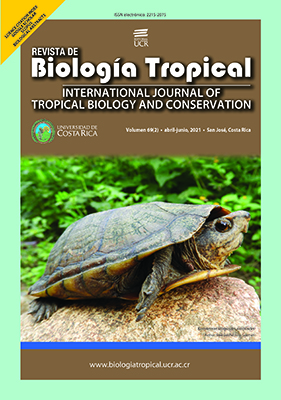Resumen
Introducción: En el hábitat natural, el estado nutricional insatisfactorio de un número elevado de ejemplares es expresión de la influencia de factores desfavorables. Objetivo: Determinar variaciones espacio-temporales en el estado nutricional de langostas Panulirus argus, relacionarlas con variaciones reportadas en la comunidad bentónica y demostrar, mediante la aplicación de indicadores analíticos y morfométricos, que la variación de factores ambientales afecta a ambos grupos de índices; y que no todos los índices de condición nutricional evidencian por igual el impacto generalizado del proceso de deterioro ambiental en este golfo. Métodos: Las langostas se capturaron en seis áreas de pesca. La condición nutricional se estimó mediante tres índices no destructivos, poco costosos y de fácil y rápida aplicación (extensivos): índice de refracción de la hemolinfa (IRH), relación peso total / largo total = Klt, y factor de condición (FCA). Las variaciones a largo plazo (60 años) se determinaron mediante índices morfométricos (Klt y FCA). Se analizaron datos de los períodos 1963-1964 (N = 29 001), 1983-1993 (N = 3 123) y 2011-2017 (N = 3 600), separándolos en épocas de Lluvia y Seca. Resultados: En todos los períodos la condición nutricional varió significativamente entre áreas, pero sin similitudes entre períodos. Esto indica que los factores que impactan en el estado nutricional tienen una influencia estocástica más característica de factores ambientales. Aunque los tres índices fueron menores en 2017, sólo IRH disminuyó gradualmente entre 2011 y 2017, lo que sugiere que este índice, y los morfométricos, expresan diferente información. Todas las correlaciones fueron estadísticamente significativas, los coeficientes más altos se establecieron entre los índices morfométricos. El peso total y el Klt no mostraron diferencias entre Seca y Lluvia. Sin embargo, IRH y FCA resultaron mayores en Seca, hecho que se constató para cada sexo. FCA y Klt no presentaron diferencias entre el período 1963-1964 y el período 1983-1993, pero aumentaron (P < 0.05) en el período 2011-2017, lo que, dado el carácter morfométrico de estos índices, se atribuye a la presencia de langostas de mayor peso en las áreas de pesca. Conclusiones: Los menores valores en 2017 y la tendencia gradual al decrecimiento de IRH, corroboran el carácter generalizado del deterioro ambiental en el golfo de Batabanó, lo cual no fue igualmente expresado por los tres índices.
##plugins.facebook.comentarios##

Esta obra está bajo una licencia internacional Creative Commons Atribución 4.0.
Derechos de autor 2021 Alexander Lopeztegui Castillo, Norberto Capetillo Piñar



